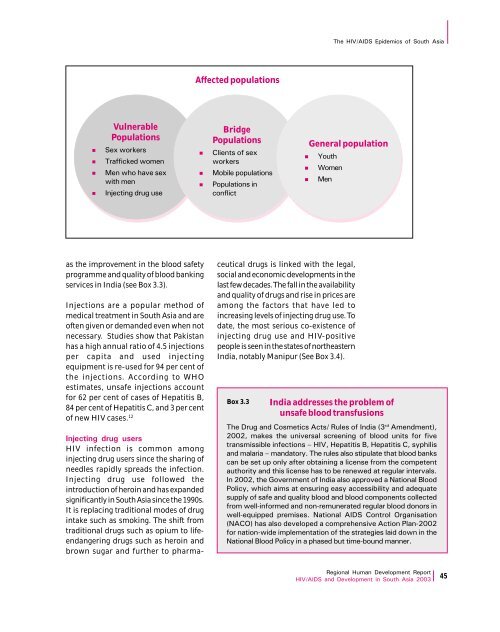Download Report - UNDP Asia-Pacific Regional Centre - United ...
Download Report - UNDP Asia-Pacific Regional Centre - United ...
Download Report - UNDP Asia-Pacific Regional Centre - United ...
You also want an ePaper? Increase the reach of your titles
YUMPU automatically turns print PDFs into web optimized ePapers that Google loves.
The HIV/AIDS Epidemics of South <strong>Asia</strong>Affected populationsnnnnVulnerablePopulationsSex workersTrafficked womenMen who have sexwith menInjecting drug usennnBridgePopulationsClients of sexworkersMobile populationsPopulations inconflictnnnGeneral populationYouthWomenMenas the improvement in the blood safetyprogramme and quality of blood bankingservices in India (see Box 3.3).Injections are a popular method ofmedical treatment in South <strong>Asia</strong> and areoften given or demanded even when notnecessary. Studies show that Pakistanhas a high annual ratio of 4.5 injectionsper capita and used injectingequipment is re-used for 94 per cent ofthe injections. According to WHOestimates, unsafe injections accountfor 62 per cent of cases of Hepatitis B,84 per cent of Hepatitis C, and 3 per centof new HIV cases. 12Injecting drug usersHIV infection is common amonginjecting drug users since the sharing ofneedles rapidly spreads the infection.Injecting drug use followed theintroduction of heroin and has expandedsignificantly in South <strong>Asia</strong> since the 1990s.It is replacing traditional modes of drugintake such as smoking. The shift fromtraditional drugs such as opium to lifeendangeringdrugs such as heroin andbrown sugar and further to pharmaceuticaldrugs is linked with the legal,social and economic developments in thelast few decades. The fall in the availabilityand quality of drugs and rise in prices areamong the factors that have led toincreasing levels of injecting drug use. Todate, the most serious co-existence ofinjecting drug use and HIV-positivepeople is seen in the states of northeasternIndia, notably Manipur (See Box 3.4).Box 3.3India addresses the problem ofunsafe blood transfusionsThe Drug and Cosmetics Acts/ Rules of India (3 rd Amendment),2002, makes the universal screening of blood units for fivetransmissible infections – HIV, Hepatitis B, Hepatitis C, syphilisand malaria – mandatory. The rules also stipulate that blood bankscan be set up only after obtaining a license from the competentauthority and this license has to be renewed at regular intervals.In 2002, the Government of India also approved a National BloodPolicy, which aims at ensuring easy accessibility and adequatesupply of safe and quality blood and blood components collectedfrom well-informed and non-remunerated regular blood donors inwell-equipped premises. National AIDS Control Organisation(NACO) has also developed a comprehensive Action Plan-2002for nation-wide implementation of the strategies laid down in theNational Blood Policy in a phased but time-bound manner.<strong>Regional</strong> Human Development <strong>Report</strong>HIV/AIDS and Development in South <strong>Asia</strong> 2003 45
















